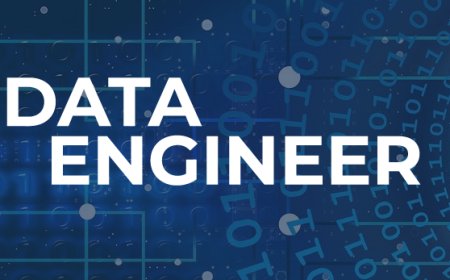Best Practices for Creating an Effective Data Engineering Roadmap
Explore proven strategies and expert insights for crafting a successful data engineering roadmap. Elevate your data infrastructure with best practices and key insights.

Ever planned a road trip? Think of data engineering as that detailed map guiding your journey. Just as a map prevents you from getting lost, a well-thought-out data plan keeps us on track in the digital world.
Imagine your data as precious gems. A plan is our way of handling and preserving these treasures wisely collecting, storing, and processing them strategically. It's like organizing a library: every book (or data point) has its spot, making it easy to find what you need.
But it's not just about appearances. This organized structure unlocks the true value of your data. Think of it as having your favorite snack handy when hunger strikes it's all about convenience meeting efficiency.
So, when we say utilization, we're talking about making the most out of your data. A well-crafted plan ensures the right data is always at your fingertips, ready when you need it most. That's the power of a smart data roadmap!
Understanding the Current State of Data Engineering
1. Tackling Data Management Challenges
Businesses grapple with obstacles in managing data efficiently, including concerns about quality, integration, and accessibility. Inadequate data engineering disrupts business operations, leading to increased costs and diminished performance.
2. Recognizing Changes in the Role of Data
The role of data in decision-making is dynamic, with real-time data and increasing volumes requiring adaptation. Organizations must adopt flexible strategies, incorporating real-time processing and scalable solutions for effective data management.
Key Considerations for an Effective Data Engineering Roadmap
Defining Objectives:
Identifying specific goals:
-
Clarify Business Outcomes: Clearly define the business outcomes you aim to achieve through data engineering, such as improving decision-making, enhancing customer experience, or optimizing operational efficiency.
-
Quantifiable Metrics: Establish quantifiable metrics to measure success, providing a clear understanding of the impact of your data initiatives on organizational goals.
Aligning objectives:
-
Business-Data Alignment: Ensure that your data objectives align with broader business objectives. This alignment is crucial for demonstrating the value of data engineering initiatives to stakeholders.
-
Impact Assessment: Regularly assess and communicate how data initiatives contribute to achieving overall business objectives.
Stakeholder Collaboration:
Involving key stakeholders:
-
Identify Stakeholder Roles: Clearly define the roles of key stakeholders, including business leaders, analysts, IT teams, and data scientists.
-
Early Engagement: Involve stakeholders early in the roadmap creation process to gather diverse perspectives and insights.
Fostering a collaborative approach:
-
Cross-Functional Teams: Encourage collaboration between cross-functional teams to ensure a holistic understanding of business requirements and technical constraints.
-
Regular Feedback Loops: Establish regular feedback loops to incorporate insights from stakeholders throughout the roadmap execution.
3. Technology Stack Selection:
Evaluating and selecting the right technologies:
-
Needs Assessment: Conduct a thorough needs assessment to understand the specific requirements for data processing, storage, and analytics.
-
Proof of Concept: Consider implementing proof-of-concept projects to validate the compatibility and effectiveness of chosen technologies.
Balancing innovation with practicality:
-
Risk Assessment: Evaluate the risks associated with adopting new technologies and balance innovation with the practical considerations of your organization's capabilities.
-
Long-Term Viability: Select technologies that not only meet current needs but also have long-term viability and support.
4. Scalability and Flexibility:
Building a roadmap for scalability and flexibility:
-
Capacity Planning: Plan for capacity growth by assessing current and future data processing and storage requirements.
-
Modular Architecture: Design a modular architecture that allows for easy integration of new technologies and scalability without significant disruptions.
Anticipating future needs:
-
Continuous Monitoring: Stay informed about emerging technologies and industry trends to anticipate future data engineering needs.
-
Adaptive Planning: Incorporate adaptive planning methodologies to respond to evolving business and technological landscapes.
5. Data Governance Framework:
Establishing a robust data governance framework:
-
Define Data Ownership: Clearly define roles and responsibilities for data ownership, ensuring accountability for data quality and security.
-
Policy Development: Develop comprehensive data governance policies covering aspects such as data privacy, security, and compliance.
Ensuring compliance, security, and data quality:
-
Regular Audits: Conduct regular audits to ensure compliance with data governance policies and industry regulations.
-
Data Quality Measures: Implement measures such as data profiling, cleansing, and validation to maintain high data quality standards.
Best Practices for Crafting a Data Engineering Roadmap
Iterative Planning and Review:
Think Flexibly:
Break down your data engineering roadmap into smaller, manageable phases. This enables a more flexible and adaptable approach to development. Be open to adjusting plans as the project progresses. Flexibility allows for better alignment with the evolving needs of the business.
Regular Check-ins:
Schedule regular reviews of your data engineering roadmap to ensure it stays aligned with the overall business strategy. Actively seek feedback from stakeholders to promptly incorporate any changes or new requirements into your roadmap.
Agile Implementation:
Stay Nimble: Embrace an agile methodology for data engineering projects. This involves iterative development, allowing for quick adjustments based on feedback. Break down complex tasks into smaller, more manageable ones, making it easier to adapt to changing priorities.
Prioritize Smartly: Evaluate tasks based on their impact on business goals and prioritize them accordingly. This ensures that the team is working on high-value items first. Regularly reassess priorities in collaboration with business stakeholders to stay aligned with changing business needs.
Continuous Monitoring and Optimization:
Keep an Eye Out: Implement monitoring tools to keep a constant watch on data workflows and processes.Set up alerts for potential issues to catch and address them proactively, minimizing downtime and ensuring data quality.
Tune Up Regularly: Utilize performance insights gathered through monitoring to optimize data workflows. Regularly review and refine processes to improve efficiency and responsiveness to changing data requirements.
Documentation and Communication:
Write It Down: Emphasize the importance of clear and comprehensive documentation for all aspects of the data engineering roadmap. Document decisions, processes, and configurations to ensure that knowledge is accessible to the entire team.
Talk It Out: Facilitate effective communication between teams involved in data engineering. Regular meetings and transparent communication channels help prevent misunderstandings. Encourage collaboration and information sharing to foster a cohesive and informed team environment.
Training and Skill Development:
Invest in Learning: Allocate resources for training programs to enhance the skills of the data engineering team. Stay updated on industry best practices and emerging technologies to ensure that the team remains competitive and proficient.
Knowledge is Power: Regularly assess the skills and knowledge gaps within the team and address them through targeted training and development initiatives. Foster a culture of continuous learning to keep the team well-equipped to handle evolving challenges in the data engineering landscape.
Measuring Success and Continuous Improvement
Defining Success Metrics
Key Performance Indicators (KPIs): Start by picking specific KPIs that connect with your business goals. These should be measurable and directly linked to the success of your data engineering efforts.
For example, if your aim is to enhance data processing speed, a relevant KPI could be the average time it takes to process a given amount of data.
Quantifiable Business Impact: Look beyond technical metrics and consider how your data engineering work contributes to the overall success of the business. This could include improvements in decision-making, cost savings, or revenue generation. Quantify these impacts to create a clear link between your efforts and tangible business outcomes.
Establishing Feedback Loops
Learning from Implementation: Set up a robust feedback system that encourages input from end-users, stakeholders, and other relevant parties. Regularly ask for feedback on the performance, usability, and effectiveness of the data engineering solutions you've implemented. This can be done through surveys, user interviews, or monitoring tools.
Continuous Improvement Strategies: Develop strategies for continuous improvement based on the feedback received. This might involve refining existing processes, addressing user pain points, or optimizing data workflows. Consider implementing agile methodologies that allow for iterative development, making it easier to incorporate feedback and adapt to changing business needs.
In conclusion, an effective data engineering roadmap relies on strategic planning and key considerations. Begin by defining clear data goals aligned with business objectives. Prioritize data sources, set quality standards, and build scalability for future growth. Encourage collaboration among teams to ensure a holistic understanding of data requirements. Implement robust data governance practices for integrity and compliance. Regularly reassess and update the roadmap to adapt to evolving business needs and technological advancements.











































